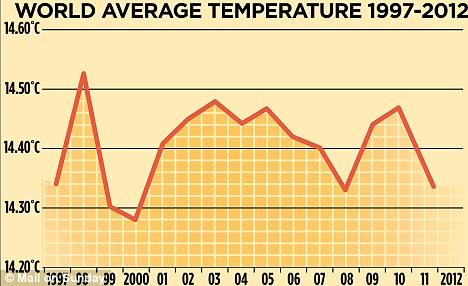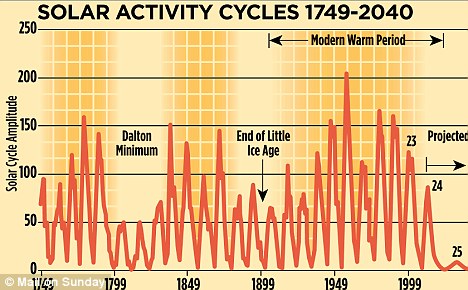For many years, the University of East Anglia’s Climatic Research Unit has been one of the main drivers of the argument that the earth is warming dangerously and it’s all due to human activity. In recent years, it has been proven, by the words of the researchers themselves in leaked emails (Climategate), that these claims are false and the data has been deliberately manipulated to “prove” their case. Despite this, they have continued to trot out data showing an alarming increase in global temperatures.
So you can imagine my surprise when the Climatic Research Unit released data last week which showed that the planet has not warmed since 1997. This new data is roughly in line with the raw data emanating from satellites which measure the planet’s temperature, and what the old manipulated data should have looked like if it hadn’t been manipulated.

(h/t The Daily Mail [1])
Not surprisingly, the data was released very quietly. Any time data is released (usually by a body related to the United Nations) which shows some alarming end-of-the-world-is-nigh warming, it is released to a lot of fanfare and all of the usual suspects such as Tim Flannery, Phil Jones and, to a lesser extent these days, Al Gore plaster their dire warnings across all of the media. For this data though…I’d be willing to bet that the majority of the people reading this here or in The Daily Mail On Sunday were hearing about it for the first time.
The Daily Mail On Sunday reports that [1], reminiscent of the 1970s, some scientists are now warning of an impending ice age because of, wait for it, a lack of solar activity! Yes, that’s right, the big glowing thing in the sky which has been proven to have a fairly substantial effect on the earth’s climate (and is our only source of heat) is now being recognised as a driver of climate by a growing number of previously “carbon dioxide will doom us all” scientists.
Based on readings from more than 30,000 measuring stations, the data was issued last week without fanfare by the Met Office and the University of East Anglia Climatic Research Unit. It confirms that the rising trend in world temperatures ended in 1997.
[..]
We are now at what should be the peak of what scientists call ‘Cycle 24’ – which is why last week’s solar storm resulted in sightings of the aurora borealis further south than usual. But sunspot numbers are running at less than half those seen during cycle peaks in the 20th Century.Analysis by experts at NASA and the University of Arizona – derived from magnetic-field measurements 120,000 miles beneath the sun’s surface – suggest that Cycle 25, whose peak is due in 2022, will be a great deal weaker still.
According to a paper issued last week by the Met Office, there is a 92 per cent chance that both Cycle 25 and those taking place in the following decades will be as weak as, or weaker than, the ‘Dalton minimum’ of 1790 to 1830. In this period, named after the meteorologist John Dalton, average temperatures in parts of Europe fell by 2C.
However, it is also possible that the new solar energy slump could be as deep as the ‘Maunder minimum’ (after astronomer Edward Maunder), between 1645 and 1715 in the coldest part of the ‘Little Ice Age’ when, as well as the Thames frost fairs, the canals of Holland froze solid.
Now, it has to be said, that the projections of what the next solar cycle will do, do seem to be a bit on the low side given the historical record and current trend.

(h/t The Daily Mail [1])
If the next solar cycle is as inactive as is predicted, then I have no doubts that we will see some significant cooling, but it doesn’t even have to be that low for there to be cooling. Consider the daily effect of the sun on a given section of the earth. At dawn, the sun starts to shine but can only slow down the falling temperature at first, until the sun’s intensity rises a bit and the section of the earth begins to warm. The sun reaches peak intensity at around midday, however the planet continues to warm for the next few hours. The sun, with diminished intensity, is able to maintain temperatures through the late afternoon, and it is only when the sun is about to disappear that temperatures really start to drop, and then when the sun goes away completely it still takes an hour or two for temperatures to enter a free-fall. Put simply, daily temperatures trail the sun’s intensity by a few hours.
In the same way, it seems to be quite plausible that the overall temperature of the earth trails the sun’s intensity by a period of time. We have seen a drop off in solar intensity of late, temperatures plateaued for a while (like the late afternoon) and are now appearing to enter a period of falling (half a degree last year). The sun’s intensity does not currently seem to be enough to raise temperatures, but is enough to prevent a free-fall in temperatures. If the next solar cycle matches the intensity of this solar cycle, it is probable that temperatures will continue to fall ever-so-slightly.
All of that said, the effect of the sun on global temperatures, while currently appearing to be linked, is still largely based on historical data which is somewhat sporadic. As Pal Brekke, senior adviser at the Norwegian Space Centre said in the Daily Mail On Sunday article:
Nature is about to carry out a very interesting experiment,’ he said. ‘Ten or 15 years from now, we will be able to determine much better whether the warming of the late 20th Century really was caused by man-made CO2, or by natural variability.
Indeed. Carbon Dioxide controlling the climate is now pretty much a debunked theory, and the next ten to fifteen years will determine whether the sun truly is the main driver of the climate.
Meanwhile, it is worth noting that sixteen prominent scientists co-wrote an opinion piece in The Wall Street Journal on Friday [2], commenting on the fact that a growing number of scientists are expressing concern with the growing disparity between the “carbon dioxide is causing global warming” models and the reality of the world’s temperatures. Among the highlights of their writing:
In spite of a multidecade international campaign to enforce the message that increasing amounts of the “pollutant” carbon dioxide will destroy civilization, large numbers of scientists, many very prominent, share the opinions of Dr. Giaever. And the number of scientific “heretics” is growing with each passing year. The reason is a collection of stubborn scientific facts.
Perhaps the most inconvenient fact is the lack of global warming for well over 10 years now. This is known to the warming establishment, as one can see from the 2009 “Climategate” email of climate scientist Kevin Trenberth: “The fact is that we can’t account for the lack of warming at the moment and it is a travesty that we can’t.” But the warming is only missing if one believes computer models where so-called feedbacks involving water vapor and clouds greatly amplify the small effect of CO2.
The lack of warming for more than a decade—indeed, the smaller-than-predicted warming over the 22 years since the U.N.’s Intergovernmental Panel on Climate Change (IPCC) began issuing projections—suggests that computer models have greatly exaggerated how much warming additional CO2 can cause. Faced with this embarrassment, those promoting alarm have shifted their drumbeat from warming to weather extremes, to enable anything unusual that happens in our chaotic climate to be ascribed to CO2.
The fact is that CO2 is not a pollutant. CO2 is a colorless and odorless gas, exhaled at high concentrations by each of us, and a key component of the biosphere’s life cycle. Plants do so much better with more CO2 that greenhouse operators often increase the CO2 concentrations by factors of three or four to get better growth. This is no surprise since plants and animals evolved when CO2 concentrations were about 10 times larger than they are today. Better plant varieties, chemical fertilizers and agricultural management contributed to the great increase in agricultural yields of the past century, but part of the increase almost certainly came from additional CO2 in the atmosphere.
[..]
If elected officials feel compelled to “do something” about climate, we recommend supporting the excellent scientists who are increasing our understanding of climate with well-designed instruments on satellites, in the oceans and on land, and in the analysis of observational data. The better we understand climate, the better we can cope with its ever-changing nature, which has complicated human life throughout history. However, much of the huge private and government investment in climate is badly in need of critical review.
[..]
Claude Allegre, former director of the Institute for the Study of the Earth, University of Paris; J. Scott Armstrong, cofounder of the Journal of Forecasting and the International Journal of Forecasting; Jan Breslow, head of the Laboratory of Biochemical Genetics and Metabolism, Rockefeller University; Roger Cohen, fellow, American Physical Society; Edward David, member, National Academy of Engineering and National Academy of Sciences; William Happer, professor of physics, Princeton; Michael Kelly, professor of technology, University of Cambridge, U.K.; William Kininmonth, former head of climate research at the Australian Bureau of Meteorology; Richard Lindzen, professor of atmospheric sciences, MIT; James McGrath, professor of chemistry, Virginia Technical University; Rodney Nichols, former president and CEO of the New York Academy of Sciences; Burt Rutan, aerospace engineer, designer of Voyager and SpaceShipOne; Harrison H. Schmitt, Apollo 17 astronaut and former U.S. senator; Nir Shaviv, professor of astrophysics, Hebrew University, Jerusalem; Henk Tennekes, former director, Royal Dutch Meteorological Service; Antonio Zichichi, president of the World Federation of Scientists, Geneva.
(h/t The Wall Street Journal, and US radio host Joe ‘Pags’ Pagliarulo for bringing it to my attention)
Effectively what they are advocating is for us to do what we have always done: adapt to an ever-changing climate, and to spend money on researching a myriad of climate theories rather than obsessing on a debunked one.
I can support that. I’m ready to adapt to colder weather with what seems to be a growing number of heavy jackets, and warmer weather with an easily increasable number of light t-shirts.
Samuel